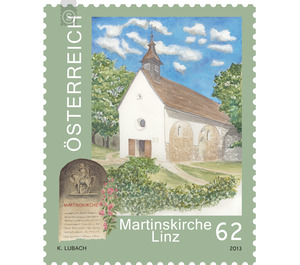churches - Austria / II. Republic of Austria 2013 - 62 Euro Cent
Theme: Architecture
| Country | Austria / II. Republic of Austria |
| Issue Date | 2013 |
| Face Value | 62.00 |
| Edition Issued | 400,000 |
| Printing Type | offset |
| Stamp Type | Commemorative |
| Item Type | Stamp |
| Chronological Issue Number | 2440 |
| Chronological Chapter | OOS-OE2 |
| SID | 217431 |
| In 61 Wishlists | |
Continuation of the popular series "Churches in Austria" - the new value focuses on one of the oldest local churches, the Martinskirche in Linz. The pretty, designed by Kirsten Lubach brand motif shows a watercolor of the rectory, decorative staged with an in the foreground to see old memorial stone in honor of St. Martin. In the immediate vicinity of the castle of Linz, on the foothills of the Roman mountain, is the spiritual heart of the city: the Roman Catholic Church of St. Martin, whose characteristic structure hides almost modestly behind several mighty trees. The Martinskirche is, as mentioned above, one of the oldest sacral buildings in Austria, its history has been closely rooted for more than 1,200 years with that of the city of Linz. The former medieval fortification wall once led from the Linz Castle over the promenade, the moat and the Pfarrplatz back to the castle. The Martinskirche was initially outside of this fortification, but counted because of their proximity to the protected area of the castle. The first mention of the church as "capella" dates back to the year 799. At that time, Linz was a market town - several centuries had to pass in the episode, then, before Linz in 1246 was raised to the city. In the exterior of the plant Romanesque elements in the form of the typically articulated arches are visible in the masonry. The interior, which experienced a highly eventful history, however, has a long rectangular floor plan with a chancel. The equipment has been changed over time, of course, again and again. Particularly noteworthy are preserved Roman tombstones with inscriptions from the 3rd century, several Gothic wood sculptures and a replica of the Volto Santo crucifix of Lucca, a highly venerated picture of grace from the first half of the 15th century on the northern nave wall. Legend has it that the face of the 8th-century original was carved by angels; However, the interpretation of the long robe attributed to a female saint also remains enigmatic. After more than 1,200 years of history, the Martinskirche is still an extremely lively center, both from a liturgical and musical point of view. It is part of the parish of St. Matthias and is available for worship, concerts and guided tours. On the last Sunday of each month, an ecumenical evening mass is celebrated here - a beautiful symbol of the common roots of the Christian churches in Linz.


